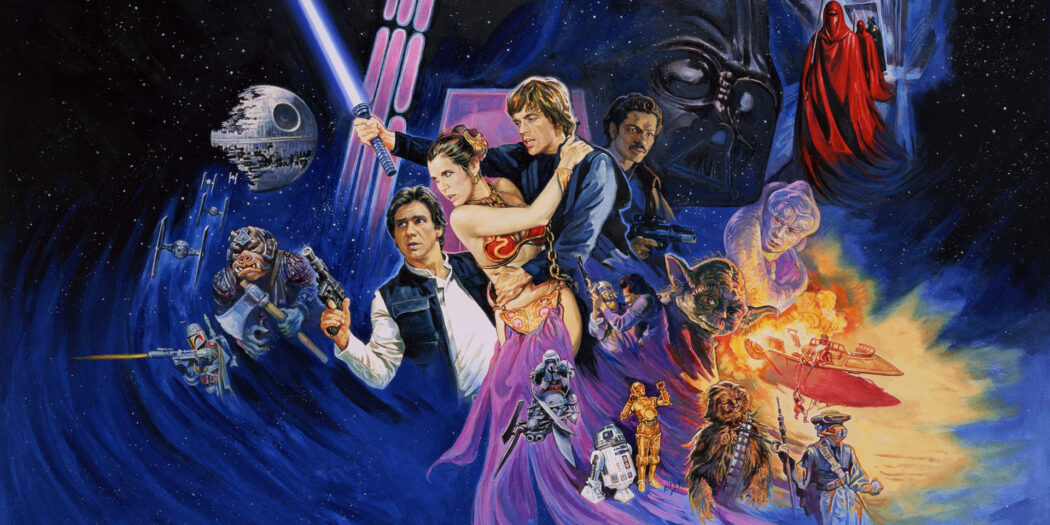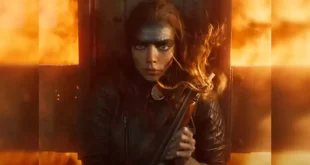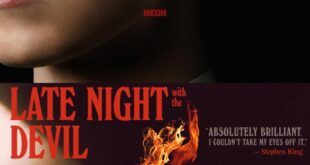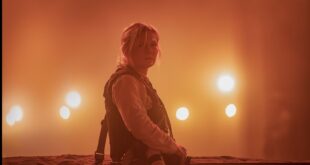Return of the Jedi is the third installment in the original Star Wars trilogy and the sixth episode in the greater Skywalker saga. Building on the success of A New Hope and The Empire Strikes Back, Return of the Jedi delivers a satisfying conclusion to the trilogy, tying up loose ends and providing an emotional resolution for its beloved characters. I am also happy to say I could see it on the big screen for the first time (it’s back in cinemas until May 4). I don’t recall ever going to the re-releases of the original trilogy in 1997, so I had never seen one of them in theaters. Parents who grew up probably going to see it in theaters themselves took their kids. It was nice to see. Jedi is the weakest of the original trilogy, no doubt about that, but there are enough endearing elements to still put it in the upper half of Star Wars films.

The film begins with the Rebel Alliance planning a daring rescue mission for Han Solo, captured and frozen in carbonite by the bounty hunter, Boba Fett. Luke Skywalker, Princess Leia, Lando Calrissian, Chewbacca, and the droids C-3PO and R2-D2 infiltrate Jabba the Hutt’s palace on Tatooine to save their friend. After overcoming several challenges, the team frees Han and escapes the clutches of the Hutt crime lord. The rebels regroup and learn about constructing a second, more powerful Death Star. Determined to prevent the Empire from completing this weapon, they embark on a risky mission to destroy it. Meanwhile, Luke faces the truth about his lineage. He finally confronts Darth Vader and Emperor Palpatine, ultimately redeeming his father and fulfilling his destiny as a Jedi.
One of the biggest strengths of Return of the Jedi is its character development. The film effectively continues the arcs of the main characters from the previous two movies in the trilogy, and it also introduces new and memorable characters, such as the Ewoks. The relationships between the characters are well-written and acted, which is a significant reason why the film continues to be so beloved. It does an excellent job of continuing the character arcs of the main characters from the previous movies while also introducing new characters and developing their arcs. For example, we see Luke Skywalker struggling with the temptation of the dark side, Han Solo and Leia grappling with their feelings for each other, and Darth Vader struggling with allegiance to the Empire. These arcs are handled with nuance and subtlety, making the characters feel fully realized and relatable.

There are a few weaknesses. However, first, let me defend the Ewoks! I don’t think the Ewoks were a weakness of the film. The Ewoks play a pivotal role in the defeat of the Galactic Empire in the original Star Wars trilogy. In Return of the Jedi, the Ewoks ally themselves with the Rebel Alliance and use their knowledge of the forest to help take down the Empire’s shield generator on Endor. This allows the Rebel fleet to attack and ultimately destroy the second Death Star, a significant turning point in the war against the Empire. The Ewoks also represent the triumph of the underdog. Despite their small size and seemingly primitive technology, the Ewoks can hold their own against Imperial stormtroopers, using their knowledge of the forest and ingenuity to outmaneuver and outsmart their enemies. This is a powerful message about the strength of determination and the ability of even the most minor and seemingly weakest individuals to make a difference. At first glance, they may seem like a frivolous addition to the Star Wars universe, but they are a crucial part of the story, providing important themes and messages that resonate with audiences of all ages.

Among the other positives are the performances. Mark Hamill delivers his best performance as Luke Skywalker, showcasing the character’s growth and maturity throughout the trilogy. Hamill was in a car accident between Empire and Jedi, and you can tell he looks different, but also, compared to how he looked in New Hope, he seems a lot more mature in just six years. Carrie Fisher’s performance as Leia is also her best in the series. She brings a sense of strength, intelligence, and vulnerability to the character, elevating her beyond the typical damsel in distress. Leia is no longer just a brave rebel fighter; she is now a commander and leader of the rebellion. Billy Dee Williams brings more maturity to Lando as well. The screenwriters went out of the way to ensure we know that Lando is a good guy despite what he was forced to do in Empire. Harrison Ford does an excellent job as Han Solo, but you can’t help but notice that he doesn’t want to be there anymore, or at least that’s what it looks like. Unlike Hamill and Fisher, Ford was only contracted to do two films. By 1982, Raiders of the Lost Ark had come out, and Harrison Ford etched his place in American pop culture. Ian McDiarmid gives an unforgettable performance as the Emperor, and the ending with Luke, Vader, and the Emperor is still a compelling film element.
Return of the Jedi boasts impressive visual effects and set designs, from the lush forests of Endor to the intimidating Death Star. The creature and costume designs in Jabba’s palace showcase the imaginative and diverse world of Star Wars. John Williams’ iconic score continues to elevate the saga, with tracks like The Emperor’s Theme and The Battle of Endor becoming synonymous with the film. The Death Star, the spaceships, the creatures, and the planets in the movie are well-designed and memorable, and they help to create a rich and immersive world. The action sequences in the film are well-choreographed and exciting, and they are a significant part of what makes Return of the Jedi so much fun to watch. Richard Marquand is no David Cronenberg, David Lynch, or Steven Spielberg (the original three directors considered for Jedi); he does a solid job continuing the look and feel of the trilogy.
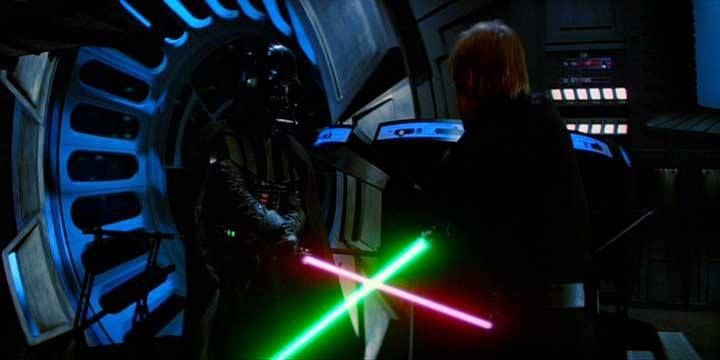
There are weaknesses. The revelation that Leia is Luke’s brother is done haphazardly and with no build-up. Especially coming after Empire, which had one of the most incredible twists in cinematic history, the sudden nature of Leia being revealed as Luke’s sister is a little jarring. The pacing isn’t always great, either. We spend too much time at Jabba the Hutt’s palace on Tatooine. It’s the opening sequence and takes almost an hour of the film. After that, we have a few brief scenes of filler then we’re already on to our main plot, which is again destroying a Death Star. Vader’s turn to good is also a little rushed though I’ll forgive it because the ending confrontation is still one of the best highlights of the film. Jedi can’t help but feel like a letdown compared to Empire.
Overall, Star Wars: Episode VI – Return of the Jedi is a well-made film that continues the strong traditions of the Star Wars franchise. With its memorable characters, exciting action sequences, and rich storytelling, it is no wonder that the film remains popular forty years after its release. I’ve always been attracted to the themes of redemption and forgiveness in the Star Wars trilogy. It’s not perfect and you can nitpick it as many Star Wars fans have done, but it does a good job concluding one of the most beloved trilogies ever.
***1/2 out of ****

 Movie Finatics The Place for Movie Lovers
Movie Finatics The Place for Movie Lovers
